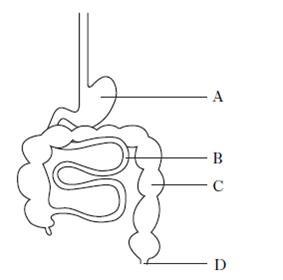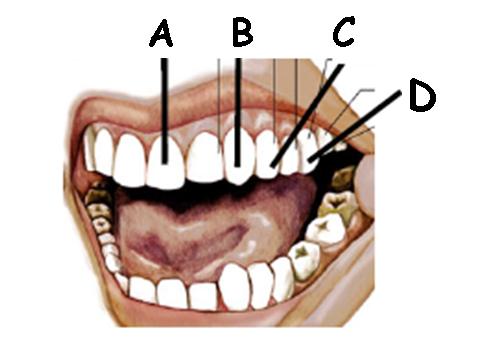|
Question 1. |
|
The diagram below shows the human alimentary canal. What structure is the small intestine? |
|
 |
|
Question 2. |
|
In the following diagram, which teeth are used to tear or grip food? |
|
 |
|
Question 3. |
|
Digestion is the process in which |
| A |
small particles of food are made into large ones so that they can be absorbed in the small intestine |
| B |
large particles of food are made into smaller ones so that they can be absorbed in the small intestine |
| C |
small particles of food are made into large ones so that they can be absorbed in the stomach |
| D |
large particles of food are made into smaller ones so that they can be absorbed in the stomach |
|
Question 4. |
|
Muscle tissue can be dark or light in colour.
Dark tissue cells use oxygen to release a lot of energy.
Light tissue cells do not use oxygen and release only a small amount of energy.
|
|
The table below shows the average percentage of dark and light tissue cells. These cells were found in the muscles of athletes training for different events at the 2014 Commonwealth games in Scotland. |
|
 |
| a) |
|
|
Present this data as a bar chart to show both the average percentage of dark and light tissues for each of the different types of athlete. |
| b) |
|
|
Which type of athlete has 3 times more dark tissue cells as light tissue cells? |
| c) |
|
|
What organ supplies the body with oxygen? |
| d) |
|
|
As well as oxygen, muscle cells need food. In which part of the digestive system is our food absorbed? |
|
|
|
Question 5. |
|
Groups of students took part in an investigation into the effect of exercise on pulse rate, as shown in the table below. |
|
 |
|
Which two groups should be compared to investigate the effect of the sex of an individual on their pulse rate during exercise? |
| A |
1 and 6 |
| B |
2 and 6 |
| C |
3 and 4 |
| D |
5 and 6 |

